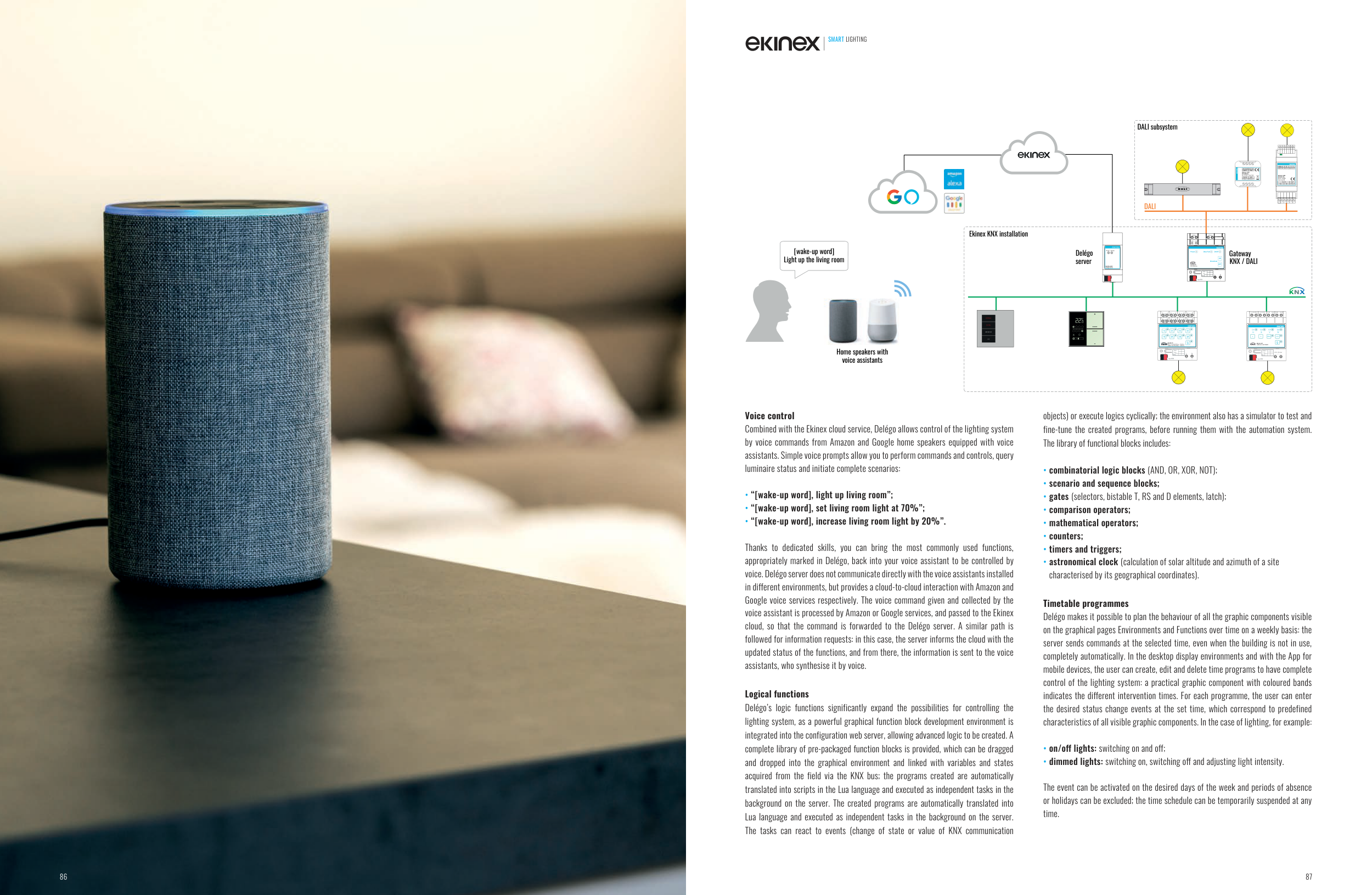Voice control
Combined with the Ekinex cloud service, Delégo allows control of the lighting system
by voice commands from Amazon and Google home speakers equipped with voice
assistants. Simple voice prompts allow you to perform commands and controls, query
luminaire status and initiate complete scenarios:
• “[wake-up word], light up living room”;
• “[wake-up word], set living room light at 70%”;
• “[wake-up word], increase living room light by 20%”.
Thanks to dedicated skills, you can bring the most commonly used functions,
appropriately marked in Delégo, back into your voice assistant to be controlled by
voice. Delégo server does not communicate directly with the voice assistants installed
in different environments, but provides a cloud-to-cloud interaction with Amazon and
Google voice services respectively. The voice command given and collected by the
voice assistant is processed by Amazon or Google services, and passed to the Ekinex
cloud, so that the command is forwarded to the Delégo server. A similar path is
followed for information requests: in this case, the server informs the cloud with the
updated status of the functions, and from there, the information is sent to the voice
assistants, who synthesise it by voice.
Logical functions
Delégo’s logic functions significantly expand the possibilities for controlling the
lighting system, as a powerful graphical function block development environment is
integrated into the configuration web server, allowing advanced logic to be created. A
complete library of pre-packaged function blocks is provided, which can be dragged
and dropped into the graphical environment and linked with variables and states
acquired from the field via the KNX bus; the programs created are automatically
translated into scripts in the Lua language and executed as independent tasks in the
background on the server. The created programs are automatically translated into
Lua language and executed as independent tasks in the background on the server.
The tasks can react to events (change of state or value of KNX communication
objects) or execute logics cyclically; the environment also has a simulator to test and
fine-tune the created programs, before running them with the automation system.
The library of functional blocks includes:
• combinatorial logic blocks (AND, OR, XOR, NOT);
• scenario and sequence blocks;
• gates (selectors, bistable T, RS and D elements, latch);
• comparison operators;
• mathematical operators;
• counters;
• timers and triggers;
• astronomical clock (calculation of solar altitude and azimuth of a site
characterised by its geographical coordinates).
Timetable programmes
Delégo makes it possible to plan the behaviour of all the graphic components visible
on the graphical pages Environments and Functions over time on a weekly basis: the
server sends commands at the selected time, even when the building is not in use,
completely automatically. In the desktop display environments and with the App for
mobile devices, the user can create, edit and delete time programs to have complete
control of the lighting system: a practical graphic component with coloured bands
indicates the different intervention times. For each programme, the user can enter
the desired status change events at the set time, which correspond to predefined
characteristics of all visible graphic components. In the case of lighting, for example:
• on/off lights: switching on and off;
• dimmed lights: switching on, switching off and adjusting light intensity.
The event can be activated on the desired days of the week and periods of absence
or holidays can be excluded; the time schedule can be temporarily suspended at any
time.
Delégo
server
KNX / DALI
Gateway
DALI
DALI subsystem
[wake-up word]
Light up the living room
Home speakers with
voice assistants
Ekinex KNX installation
SMART LIGHTING
87
86







